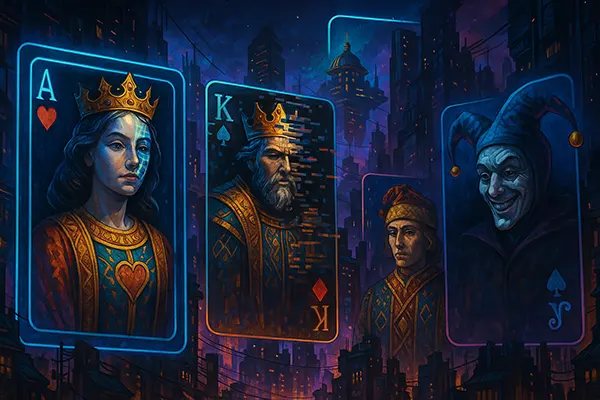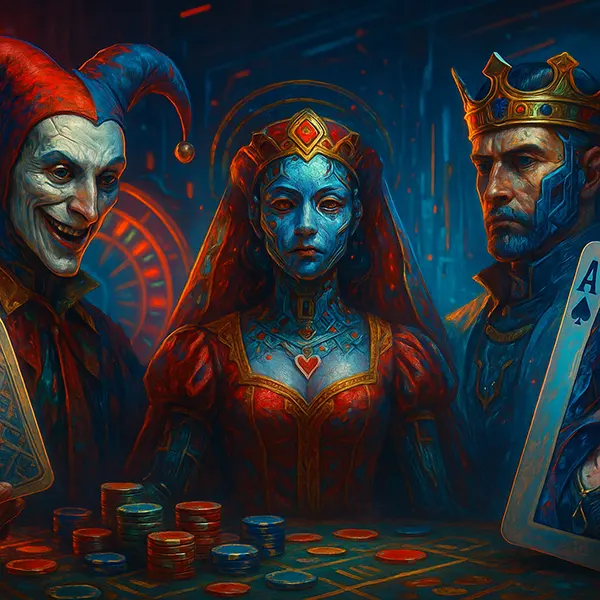
Card Game Imagery in 21st Century Avant-Garde Art: From Digital Painting to NFT
The 21st century has seen a fascinating blend of gambling symbolism and visual experimentation, particularly within the avant-garde digital art scene. Playing cards—especially queens, kings, and jokers—have resurfaced as dominant visual motifs, offering artists fresh terrain to explore themes of chance, chaos, and societal distortion. These artworks span multiple styles, from cyber-dystopian collages to algorithmic surrealism, with their presence especially potent in the NFT art landscape.
Avant-Garde Interpretations of Cards in Contemporary Art
In modern digital art, playing cards are more than nostalgic symbols—they represent risk, role-playing, and identity. Artists often reimagine these figures in neo-surrealist formats, exploring the blurred line between power and vulnerability. A queen may appear half-robotic, while a joker might take on hacker-like attributes, turning these symbols into commentaries on technology, capitalism, or existential absurdity.
One notable case is the reinterpretation of the tarot-like “Queen of Hearts” in glitch aesthetics—fragments of her crown dispersed into binary code. Such works demonstrate how classic card figures evolve into narratives of digital fragmentation and lost agency. These aren’t just card games—they’re cautionary allegories for a networked world spiralling into unpredictability.
The abstraction of suits—spades, clubs, hearts, diamonds—also plays a strong role. Many digital installations now blend these symbols with dystopian urban scenes, revealing an underground aesthetic rich in chaos, strategy, and encrypted meaning. These artworks don’t merely replicate but reconstruct playing cards as vehicles of philosophical storytelling.
Neo-Surrealism and Card Symbolism in Artistic Dialogue
Neo-surrealism thrives on juxtaposition and cognitive dissonance. When applied to card-based imagery, this leads to the unsettling placement of regal characters within disassembled realities—warped casinos, floating cities, decayed data hubs. These surrealistic cards question not only luck, but the very architecture of reality in which games of chance unfold.
Many digital creators, including those on experimental galleries like fx(hash) and Art Blocks, reprogram card figures using generative code. Jokers smile with three eyes, kings float headless above crypto-ruins, and suits become abstract glyphs rather than traditional shapes. This detachment from realism amplifies interpretative freedom.
Thus, card-based imagery is not just a thematic decoration; it’s a functional tool within surrealist storytelling. These pieces destabilise the viewer’s sense of logic and create cognitive thresholds between old-world gambling culture and speculative future mythologies.
Card Archetypes in Cyber-Dystopian and Post-Human Narratives
The cyberpunk influence is increasingly visible in artworks where card characters inhabit fractured digital landscapes. Artists reconstruct queens as augmented intelligence agents or turn kings into surveillance systems. In such environments, cards reflect a loss of personal agency—tools within corporate systems, rather than wielders of power.
Dark-toned 3D renders on marketplaces like SuperRare and Foundation often display jokers with face-recognition glitches or scanlines running across their eyes. The distortion isn’t merely stylistic—it’s symbolic of fading human traits in synthetic ecosystems. The casino no longer represents escape but algorithmic control and deep behavioural monitoring.
Moreover, the dystopian aesthetics push the narrative further: spades may now resemble military drones, hearts represented as pixelated surveillance nodes. The classical meanings of the suits—war, emotion, wealth, labour—are re-evaluated under the lens of transhuman anxiety and digitised identity collapse.
The Role of AI and Generative Systems in Shaping Card Worlds
Generative art tools like Processing, p5.js, and GAN models are increasingly responsible for producing card-based artworks with embedded randomness. These artworks embrace programmed chance—aligning ideologically with gambling itself. A digital jack may appear only when a set of code-defined probabilities are met, making each viewing unique.
This symbiosis of card game mechanics with code-based visuals creates immersive experiences. Many artists layer probability trees into their work, embedding statistical rules reminiscent of poker or blackjack. The art becomes not just aesthetic but interactive—capable of change, reaction, and mystery.
Some NFT projects incorporate smart contracts that “reveal” new aspects of a card artwork based on external data: wallet activity, time of day, or on-chain randomness. Here, the essence of gambling is not simulated—it is built into the very ontology of the artwork itself.

Crypto-Galleries and the Display of Gambling Iconography
Beyond individual artworks, the presentation format itself has evolved. Crypto-galleries—such as Decentraland’s art spaces or Oncyber’s curated exhibitions—host immersive virtual shows entirely centred around playing card characters. Visitors navigate rooms where each queen or joker is animated, reactive, and often voice-enabled via AI avatars.
These exhibitions are not gimmicks but structured environments where gambling aesthetics inform spatial storytelling. Layouts often mimic card tables, roulette layouts, or fragmented casino halls—reimagined in minimalist or brutalist styles. The intention is not to recreate a casino, but to metaphorise the randomness and power struggles inherent in our digital condition.
Particularly on OpenSea, entire collections are launched with narrative scripts, where each card is a character in a wider cyberpunk epic. These curated drops often sell out within hours, reflecting the growing appetite for storytelling-driven visual art. Cards here aren’t relics—they are contemporary totems of chaos, chance, and coded mythology.
Exhibiting Chance: From Static Card Art to Interactive Installations
Some artists now move beyond static visuals. Interactive installations on platforms like Arium or Spatial invite users to flip virtual cards, uncovering multimedia layers—voice, motion, or cryptographic puzzles. This interactivity aligns with the unpredictability central to both card games and digital immersion.
For example, flipping a card in a gallery room might trigger a video loop of a falling roulette wheel or unlock a short audio monologue from a fictional queen character. These pieces are narrative-rich and reactive, transforming digital art from object into experience.
The NFT space allows for these layers to remain mutable. Once a collector owns a piece, they might unlock exclusive layers, alternate suits, or even evolve the artwork through ownership duration. Gambling, here, becomes participatory mythology—where viewers, collectors, and creators share the odds.
